June 16, 2014: City Council Meeting Preview
The city council’s last meeting of the 2014 fiscal year on June 16, 2014 features an agenda packed with items related to the city’s physical infrastructure like bridges (including art), the sanitary sewer system and the stormwater system, as well as several resolutions related to construction of new sidewalks.

Screenshot of Legistar – the city of Ann Arbor’s online agenda management system. Image links to the June 16, 2014 meeting agenda.
Related to new sidewalk construction is a resolution that would authorize a $75,000 contract with the Greenway Collaborative, to support the work of a pedestrian safety and access task force established by the city council in late 2013. Creating a tool for setting priorities for funding and filling sidewalk gaps in the city is part of task force’s responsibility.
The $75,000 cost for the pedestrian safety task force consultant is the same amount the council will be asked to allocate to support the work of Ann Arbor SPARK, a local economic development agency. The contract with SPARK is renewed annually, as is another contract on the June 16 agenda – for lobbying services from Governmental Consultant Services Inc. The GCSI contract is for $48,000.
Also on the council’s June 16 agenda are three items with a connection to the Ann Arbor Downtown Development Authority. One is the approval of an end-of-year budget adjustment that was already approved at the DDA board’s June 4, 2014 meeting. Another is approval of a $37,500 expenditure from the city’s affordable housing trust fund to help pay for an affordable housing needs assessment. At its June 4 meeting, the DDA board authorized a $37,500 grant for the same study.
In the final item with a DDA connection, the council will be asked to authorize $69,555 for the conversion of 223 mercury vapor cobrahead streetlights to LED technology. This project would convert streetlights that are all outside the DDA district. The project is on the city council’s agenda because the DDA board recently declined to fund a similar LED conversion project – for streetlights inside the DDA tax capture district.
Several other June 16 agenda items related to the downtown area, even if they don’t have an explicit DDA connection. Two of them involve changes to downtown zoning ordinances that have been recommended by the planning commission. The zoning question to be given initial consideration by the council is whether to downzone the southeast corner of William and Main streets from D1 to D2, but with a 100-foot height limit.
Other downtown items on the council’s June 16 agenda include site plan approvals for First Martin’s hotel project at Ashley and Huron, and the Bank of Ann Arbor expansion at Fifth Avenue and Washington Street.
A resolution to improve Liberty Plaza, a downtown park at the southwest corner of Division and Liberty streets, also appears on the agenda – sponsored by mayor John Hieftje and Christopher Taylor (Ward 3).
The council will be asked to approve four items related to supportive services for the criminal justice system: (1) a $76,242 contract with Washtenaw County Community Support & Treatment Services for mental health treatment services for the 15th District Court’s sobriety and mental health courts; (2) a $44,200 contract with the Washtenaw County sheriff’s office to provide drug abuse screening and monitoring services for the mental health court; (3) a $108,174 contract with Dawn Farm for drug abuse counseling and rehabilitative services; and (4) a $40,000 contract with Reiser and Frushour PLLC to provide legal representation as court-appointed counsel to indigent defendants.
Recycling is the final topic with multiple items on the June 16 agenda. The council will be asked to approve funds for a $95,694 contract with Recycle Ann Arbor to create a multi-family recycling incentive pilot program. The council will also be asked to approve $39,480 to reimburse the city’s operator of its materials recovery facility for repair of a conveyor that feeds the baler. And finally, the council will be asked to approve $35,000 for Recycle Ann Arbor to provide solid waste services associated with student move-out activity.
The June 16 council meeting will also feature the annual historic district commission awards and the introduction of one of the Ann Arbor police department’s K-9 units, who won highest honors at a recent national certification trials event.
This article includes a more detailed preview of many of these agenda items. More details on other agenda items are available on the city’s online Legistar system. The meeting proceedings can be followed Monday evening live on Channel 16, streamed online by Community Television Network starting at 7 p.m.
Physical Infrastructure
The council’s June 16 agenda is heavy with items related to the city’s physical infrastructure.
Physical Infrastructure: Fuller Road Bridges
The council will be asked to approve a $187,184 contract with Northwest Consultants Inc. for the Fuller Road, Maiden Lane, and East Medical Center Drive bridges rehabilitation project. According to the staff memo accompanying the resolution, the project includes “re-painting of each bridge, repairing corroded structural steel, bridge abutment and pier (substructure) repairs, expansion joint removal and replacement, bridge deck patching, placing an overlay on the existing bridge decks, bridge railing repairs, guard rail upgrades, brush trimming and removal around the perimeter of the bridge structures, and other related work.”
Money for the design work is available in the approved FY 2014 public services area street millage capital budget.
The state of Michigan’s local bridge program pays for 95% of eligible construction expenses up to $790,000. The project will also receive $1,373,440 in federal surface transportation funding, administered through the Michigan Dept. of Transportation. The federal program pays for 81.85% of eligible construction expenses. But neither the state nor the federal sources will pay for the design work that the council’s action will fund.
Physical Infrastructure: Stadium Bridges Art
The council will be asked to approve a contract with Widgery Studio LLC to fabricate and install public art at the East Stadium Boulevard bridges. The city had already contracted with Widgery on May 20, 2014 for $8,248 to finalize the structural design of the artwork with an engineer. This amendment to the contract on the June 16 council agenda adds art fabrication and installation services to the existing agreement, bringing the total compensation to $353,552 for all services.
This was one of the projects for which the city council left funding in place, when it voted on March 3, 2014 to transfer most of the unspent money from the now defunct Percent for Art funding program back to the funds from which the money was originally drawn.
By way of additional background, in early August of 2013, Catherine Widgery of Cambridge, Mass. was recommended as the artist for this public art project. She was picked by a selection panel from four finalists who had submitted proposals for the project, which has a $400,000 total budget. [.pdf of Widgery's original proposal]
The selection panel provided feedback to Widgery and asked that she revise her proposal before it was presented to the Ann Arbor public art commission and then later to the city council for approval. Members of the panel were Wiltrud Simbuerger, Bob Miller, Nancy Leff, David Huntoon and Joss Kiely. [.pdf of panel feedback]
The public art commission recommended the project’s approval at its April 23, 2014 meeting.
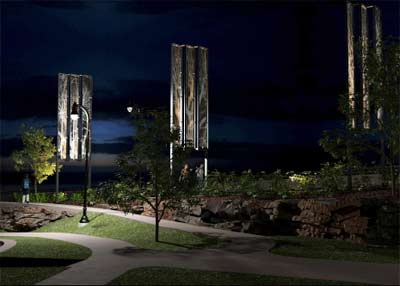
An image by artist Catherine Widgery for artwork on the East Stadium bridge. This night view shows how the structures would be lit from below, illuminating the images of trees that are etched into louvered glass panels.
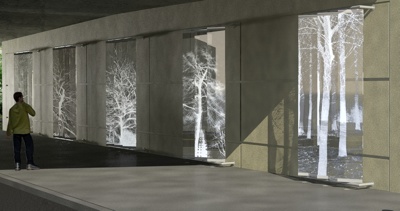
An image of proposed artwork by Catherine Widgery below East Stadium bridge, along South State Street.

An image of proposed artwork by Catherine Widgery below East Stadium bridge, along South State Street.
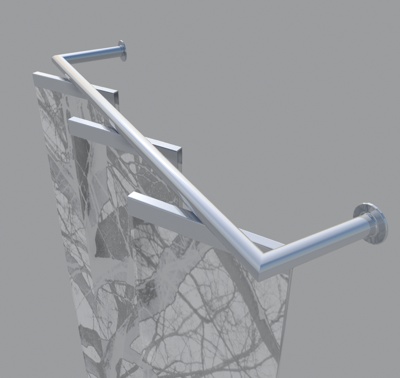
A detail of the louvers designed by Catherine Widgery. The etched glass panels will be attached to a metal frame.
Physical Infrastructure: Sewer Lining
The council will be asked to approve the award of a $1,566,121 construction contract with Lanzo Lining Services for the 2014 sewer lining project.
According to the staff memo accompanying this item, the project includes the lining of about 18,028 lineal feet of sanitary sewer and 2,942 lineal feet of storm sewer at 16 locations throughout the city. The memo describes sewer lining as a “trenchless technology which enables the pipe to be repaired without disturbing the surface above.”
Physical Infrastructure: Manholes
As part of its consent agenda, the council will be asked to award a $47,193 contract to Fonson Inc. for the Eighth Street sanitary sewer manhole replacement project.
The manholes in question are described in the staff memo accompanying the project as “101 years old, composed of brick and … disintegrating.” The deterioration of the manholes is attributed to corrosion from sewer gases, vibration from traffic, decades of freeze/thaw cycles and variations in hydrostatic soil pressures. The deteriorated condition includes spalling, weakened mortar, missing bricks and excessive groundwater infiltration, according to the memo.
Physical Infrastructure: Water Main
The council will be asked to award a $1,324,357 construction contract to Douglas N. Higgins Inc. for the Arbor Oaks Phase II water main replacement project.
This project will replace the older water mains in the Bryant neighborhood. The water mains in the neighborhood are described in a staff memo as experiencing frequent breaks and in generally poor condition. The project will install 1,100 feet of 12-inch water main and 2,360 feet of 8-inch water main along Santa Rosa Drive, Jay Lee Court, Lucerne Court, Burlingame Court, Blain Court, Hardyke Court, and Bryant Elementary School property. Included in the project is the resurfacing of the street, replacement of some curb and gutter, and reconstruction of some storm sewer structures.
Physical Infrastructure: Fire Station Restrooms
The council will be asked to approve a $149,500 contract with Emergency Restoration Company for the renovation of restrooms and locker rooms in Fire Stations #3 and #4. The staff memo accompanying the item indicates that the project will renovate the existing restroom facilities to create two unisex restrooms and showers at each station. Facilities and ventilation in the locker room and restroom areas will be improved.
Fire Station #3 is located on the city’s west side, on Jackson Road. Fire Station #4 is located on the city’s southeast side, on Huron Parkway. [Google Map of all five fire station locations]
Physical Infrastructure: Stormwater
The council will be asked to authorize transfer up to $157,264 in funds from the park maintenance and capital improvements millage fund to the stormwater fund – to authorize state revolving fund (SRF) debt payment and loan forgiveness for the stormwater and rain garden components of the skatepark project, located at Veterans Memorial Park.
According to the staff memo accompanying the resolution, a state revolving fund loan is being used to fund the rain garden installation at the skatepark and to reimburse the city’s stormwater fund. Additional stormwater components were approved by the state for 50% loan forgiveness. The transfer of funds that the council is being asked to approve is necessary for the total debt payment of $118,632.00 plus 2% interest over 20 years.
The skatepark is scheduled to have a grand opening on June 21 from 10 a.m. to 6 p.m.
Physical Infrastructure: Wastewater Study
As part of its consent agenda, the council will be asked to approve a $62,800 contract with Black & Veatch Ltd. for a water & wastewater system capital cost recovery study.
Background to this contract is June 3, 2013 city council action to change the calculation of the water and sanitary improvement charges for properties connecting to city water mains or sanitary sewers – but only for a two-year period, from July 1, 2013, through June 30, 2015. The effect of the council’s action was to reduce the connection charges considerably. It was understood at the time that the two-year period would allow for the hiring of a consultant to review the city’s fees and charges for connections to the water and sanitary sewer systems and make recommendations for revision. That’s why the Black & Veatch item appears on the council’s June 16 agenda.
The principles at stake are described in the staff memo accompanying the item as follows:
When making future changes to improvement charges and connection fees, it is important that various competing elements are satisfied. The fees must be easy to explain and easy to understand to be accepted by the users. The fees must recover costs equitably. The fees must not result in either an undue burden on existing rate payers of the systems or an undue burden on new customers connecting to the systems. The fees must be easily understood and neither over recover costs nor under recover costs. Any under-recovery of costs would place undue and inequitable financial burdens on current rate payers. To meet these goals and gain the experiences of other utilities, it is desirable to contract with a consulting firm that has nationwide experience in this area.
Physical Infrastructure: Stormwater Services
As part of its consent agenda, the council will be asked to approve the amendment of a purchase order for stormwater services with the Washtenaw County water resources commissioner.
The request of the council is to increase the amount of the existing contract with the water resources commissioner by $30,000. The existing contract was approved for FY 2011 for $69,215 with a 3% annual increase, which would have put the amount for FY 2014 and FY 2015 at $75,633 and $77,902, respectively. The council is being asked to approve funding at $105,633 and $107,902, for FY 2014 and FY 2015, respectively.
Informational Infrastructure: HR and Payroll Software
The council will be asked to approve a $570,900 contract with NuView Inc. to replace the city’s human resource and payroll system. The staff memo accompanying the item explains why the existing software, acquired in 2007, is being replaced:
In 2007, the City installed a Human Resource and Payroll system called Ultipro, by Ultimate Software. The Ultipro system included modules for Recruiting, Benefits Administration, Human Resource Administration and Payroll. The City has experienced a variety of issues related to the underlying database architecture utilized by Ultimate Software. In addition, due to changes such as new legislative requirements, the increase in recruiting volume and the increase in manual data entry involved in benefits administration, the City has found the Ultipro system unable to meet its Human Resource needs.
Sidewalk/Pedestrians
The council’s agenda features several items related to special-assessed sidewalk construction projects, as well as funding for a pedestrian safety and access task force. Four different special-assessed sidewalk construction projects are on the agenda – two public hearings to be held at the June 16 meeting (for Scio Church and Barton Drive) and two resolutions to set public hearings for future meetings (for Pontiac Trail and Stone School Road).
Sidewalk/Pedestrians: Pontiac Trail Sidewalk
Two resolutions appear on the agenda in connection with construction of a new sidewalk on Pontiac Trail – one to direct the assessor to prepare an assessment roll, and another to set a public hearing on the special assessment for July 21. The assessable cost is $72,218.
According to the staff memo accompanying the resolution, sidewalk construction would be done as part of the reconstruction of Pontiac Trail beginning just north of Skydale Drive to just south of the bridge over M-14. The project will also be adding on-street bike lanes and constructing a new sidewalk along the east side of Pontiac Trail to fill in existing sidewalk gaps and to provide pedestrian access to Olson Park and Dhu Varren Road. That’s a part of the city’s Complete Streets program.
In addition to the sidewalk, approximately 1,960 feet of curb and gutter is being added north of Skydale along Pontiac Trail to protect existing wetland areas. [.pdf of Pontiac Trail sidewalk special assessment area]
Sidewalk/Pedestrians: Stone School Sidewalk
The council has previously directed the preparation of a special assessment roll for a new sidewalk along the west side of Stone School Road. This work will be done in conjunction with the Stone School Road reconstruction project from I-94 to Ellsworth Road. The total sidewalk project cost is roughly $128,500, of which about $55,000 will be special assessed.
So the requested action of the council on June 16 will be to set a public hearing on the special assessment for July 7.
Sidewalk/Pedestrians: Barton Drive Sidewalk – Public Hearing
The sidewalk on Barton Drive would extend eastward from Bandemer Park at Longshore Drive. The cost of the Barton Drive sidewalk has been calculated to be $80,606. Of that, about $36,000 will be paid from federal surface transportation funds. Of the remaining $44,606, the city’s general fund would pay $42,626, leaving just $1,980 to be paid through the special assessment.
The city council had voted at its May 19, 2014 meeting to set the assessment roll and to schedule the public hearing for June 16.
Sidewalk/Pedestrians: Scio Church Sidewalk – Public Hearing
Another public hearing based on previous council action at its May 19 meeting will be held at the June 16 meeting – on the special assessment to fund construction of a sidewalk on Scio Church Road.
For the Scio Church sidewalk project, the total cost is expected to be $365,100. Of that, about $164,000 will be paid from a federal surface transportation grant. The remaining $201,100 will be paid out of the city’s general fund and by the special assessment of just $1,626.
Sidewalk/Pedestrians: Larchmont Traffic Calming
The council will be asked to approve a traffic calming project on Larchmont Drive at a cost of $55,000 $8,800.
The action includes an appropriation for five other traffic calming projects, totaling $55,000.
The approval of this project comes in the context of the council’s budget deliberations last month, when an amendment was offered but rejected by the council that would have cut the FY 2015 budget allocation for art administration from $80,000 to $40,000 and put the $40,000 is savings toward traffic calming projects. The amendment got support only from Sumi Kailasapathy (Ward 1), Jane Lumm (Ward 2), Jack Eaton (Ward 4), and Mike Anglin (Ward 5).
Traffic calming projects must undergo a neighborhood engagement process in which at least 60% of households support the designed project. In the case of the Larchmont project, 13 out of 15 households supported the project.
Sidewalk/Pedestrians: Pedestrian Task Force Consultant
The council will be asked to approve a $75,000 contract with The Greenway Collaborative Inc. to support the work of the pedestrian safety and access task force as a facilitator.
The task force was established through a council resolution passed on Nov. 18, 2013. Confirmed as members of the task force on Jan. 21, 2014 were: Vivienne Armentrout, Neal Elyakin, Linda Diane Feldt, Jim Rees, Anthony Pinnell, Sarah Pressprich Gryniewicz, Kenneth Clark, Scott Campbell, and Owen Jansson. The group has begun to meet and has elected Feldt to chair the task force.
The resolution on the council’s June 16 meeting agenda comes after the council voted down a resolution at on April 7, 2014 that included a $77,400 contract with Project Innovations for the facilitation work. Project Innovations had been identified by staff as a contractor uniquely qualified to do the facilitation work. Project Innovations was familiar to city staff as the facilitator for a sanitary sewer wet weather evaluation study the city is currently conducting. But subsequently the city issued an RFP (requests for proposals) for the facilitation work. [.pdf of RFP No. 893]
Task force members participated in the selection process from among three respondents to the RFP. Besides Project Innovations and the Greenway Collaborative, ENP & Associates responded to the RFP. ENP is the consultant the city used for the recent review of downtown zoning.
Business Services
On the council’s agenda are two contracts that are approved annually – one for business development services and one for lobbying services.
Business Services: Ann Arbor SPARK
As part of its consent agenda, the council will be asked to approve a $75,000 contract with Ann Arbor SPARK for economic development services. This is an annual contract. At its May 19, 2014 meeting, the council spent roughly five hours of deliberations on amendments to the FY 2015 budget, and just under 30% of that time was spent on two amendments involving SPARK – neither of which were approved by the council.
SPARK is also the entity with which the local development finance authority (LDFA) contracts for business accelerator services.
One of the proposed amendments to the FY 2015 budget would have decreased the amount of funding to SPARK from the LDFA, resulting in an increase to the amount the LDFA would have reserved for future infrastructure projects. The second budget amendment debated on May 19 would have eliminated the $75,000 in the FY 2015 budget for the contract the council will be asked to approve as part of its June 16 agenda.
Ann Arbor SPARK also receives money from other governmental units in Washtenaw County. In 2013, the $75,000 paid by the city of Ann Arbor to SPARK accounted for more than half of the $132,888 total contributed by all governmental units besides Washtenaw County. The county levies a tax under Act 88, and out of that levy, last year the county contributed $200,000, according to the information provided to the city by SPARK. [.pdf of 2013 "return on investment" from Ann Arbor SPARK] [.pdf of 2013 Ann Arbor SPARK projects]
Business Services: GCSI Lobbying
As a part of its consent agenda, the council will be asked to approve a $48,000 contract with Governmental Consultant Services Inc. for lobbying services. According to the memo accompanying the item, GCSI has contributed to Ann Arbor’s efforts to increase state funding for fire protection, land-use planning, and parks and recreation projects. GCSI is also supposed to monitor issues currently pending before the legislature and advocate for the city’s specific interests. GCSI has done this kind of work for the city of Arbor since 2001.
GCSI also provides lobbying services for Washtenaw County, as well as other local municipalities. The city’s main liaison with GSCI is Kirk Profit, an Ann Arbor resident and former Michigan state legislator.
Downtown
The council will be handling several items on its June 16 agenda that relate to the Ann Arbor Downtown Development Authority specifically, or the downtown area generally.
Downtown: DDA Budget Amendment
The council will be asked to approve a routine fiscal-year-end budget adjustment for the Ann Arbor DDA. The DDA board approved the adjustment at its June 4, 2014 meeting.
The main part of the adjustment is a $1.6 million payment made for the First & Washington parking garage, which is part of the City Apartments project. The amount was budgeted by the DDA for last year, but not paid until this year.
The rest of the adjustment is attributable to expenditures out of the DDA’s housing fund – $500,000 of it to support Ann Arbor Housing Commission projects. The remaining $37,500 went to support a countywide housing needs assessment – an amount that was approved by the board at the same June 4 meeting in a separate vote.
The DDA will end the fiscal year with $6,167,757 in fund balance. The breakdown of that total is: TIF ($619,571); Housing ($160,154); Parking ($2,161,676) and Parking Maintenance ($3,226,356).
Downtown: Affordable Housing Needs Assessment
The council will be asked to authorize $37,500 from the affordable housing trust fund to support the Washtenaw County housing needs assessment. The Ann Arbor DDA had approved the same amount at its meeting last week, on June 4, 2014.
Money from the city and DDA is being considered as “up to” amounts. Mary Jo Callan, director of the county’s office of economic and community development (OCED), told the DDA board at its June 4 meeting that $75,000 from a HUD Sustainable Communities grant would be the first money spent toward the assessment.
The firm selected by the OCED to do the needs assessment is czb LLC out of Virginia. [.pdf of RFP for the needs assessment] The current needs assessment will update a report done in 2007. According to a memo from OCED staff to the DDA, the final report will “provide a clear, easy to understand assessment of the local housing market, identify current and future housing needs, and provide specific and implementable policy recommendations to advance affordable housing. The goal for this update is to include an analysis that links transportation cost and accessibility, as well as other environmental and quality of life issues to the location of affordable housing.”
The RFP for the needs study describes the timeline for the work as including a draft for review due at the end of October 2014, with a final presentation due in mid-December.
(Not) Downtown: Streetlight LED Conversion
As part of its consent agenda, the council will be asked to approve a purchase agreement with DTE to convert 223 mercury-vapor cobrahead streetlights to LED technology. The up-front cost of the conversion will be $69,555 – but that amount will be reduced to $55,060 after rebates.
The annual electric bill from DTE for the 223 streetlights is currently $45,128. After conversion, the projected annual cost will be $30,910. The savings would result in about a 3.1-year payback period on the net cost of $55,060.
None of the streetlights to be converted are in the DDA district.
Streetlights in the DDA district were part of a similar proposal considered by the DDA board at its May 7, 2014 meeting, but postponed by the board at that meeting until June 4. By the time of the June 4 meeting, however, a decision had already been made that the DDA would not be funding an LED conversion this year. [DTE's program has an annual cycle, but is not necessarily offered every year.] If the DDA board had approved funding for converting lights in the DDA district, it would have affected 212 non-LED streetlights.
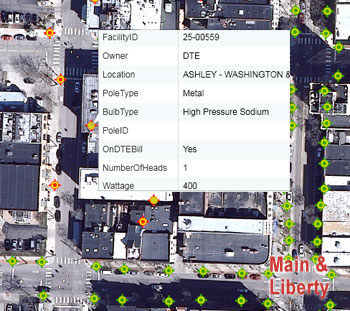
Streetlight locations are mapped in the joint Washtenaw County and city of Ann Arbor GIS system. Data available by clicking on icons includes ownership as well as the lighting technology used. This one is a high pressure sodium light operating at 400 watts.
The project the DDA declined to fund this year would have included converting 100 watt MV (mercury vapor), 175 watt MV and 100 watt HPS (high pressure sodium) lights to 65 watt LED (light emitting diode). Further, 400 watt MV and 250 watt HPS lights would have been converted to 135 watt LED. Finally, 1000 watt MV and 400 watt HPS lights would have been converted to 280 watt LED.
Currently, the city pays DTE $72,585 a year for the energy used by the 212 downtown streetlights. After conversion, the annual cost for the 212 lights would be expected to drop to $51,895, for an annual savings of $20,690.
In deliberations at the DDA board’s May 7 meeting, DDA board member Roger Hewitt opposed the grant, because the savings that would be realized accrues to the city of Ann Arbor, which pays the energy bills for the lights. Hewitt noted that the relationship between the city and the DDA includes a number of fund transfers to the city. Even though the amount is not huge, Hewitt said, the expenditure of several small amounts could eventually impair the DDA’s ability to pay for major infrastructure improvements.
Other board members joined Hewitt in their concerns, questioning what projects might be sacrificed if the DDA paid for the LED conversion. Concern was also expressed over the possibility that the result of a streetscape framework planning effort could result in a decision to replace all cobrahead lights in the downtown area with pedestrian-scale lampposts. And that would mean that the new LED fixtures would be used for only a short while.
Downtown: Zoning, Character District
The council will be asked to give initial approval to changes in two parts of the zoning code affecting the parcel at 425 S. Main, on the southeast corner of Main and William streets. Because these would be changes to the zoning code, which is expressed in city ordinances, any council action that might be taken would need a second and final vote at a future meeting, in order to be enacted.
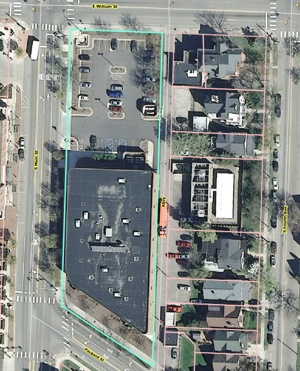
Aerial view of 425 S. Main – outlined in green – between William and Packard. An alley separates the site from a residential neighborhood along South Fourth Avenue.
Currently, a two-story 63,150-square-foot office building – where DTE offices are located – stands on the southern part of that site, with a surface parking lot on the north portion. [.pdf of staff memo on 425 S. Main rezoning]
To be considered separately by the city council are votes that would: (1) change the zoning of the parcel from D1 (downtown core base district) to D2 (downtown interface base district); and (2) change the character overlay district, of which the parcel is a part, to increase the D2 height limit from 60 feet to 100 feet. Assuming the zoning change is made for the parcel at 425 S. Main, it would be the only D2 parcel in the character district. The changes to the character overlay district also include upper story setbacks from any residential property. [.pdf of staff memo on overlay district]
The planning commission recommended both the changes at its May 6, 2014 meeting. The planning commission’s vote on the basic zoning change was unanimous – 9-0. But the vote on the 100-foot height limit was only 6-3, with dissent coming from Sabra Briere, Ken Clein and Jeremy Peters. Briere also serves on city council, representing Ward 1.
Both recommendations had been brought forward by the commission’s ordinance revisions committee (ORC). Members are Bonnie Bona, Diane Giannola, Kirk Westphal and Wendy Woods.
The planning commission’s recommendations came in response to a city council directive given at its Jan. 21, 2014 meeting, which had been based on previous work the planning commission had done. The commission had studied and developed a broader set of eight recommendations for zoning changes in specific parts of the downtown. The overall intent was in large part to buffer near-downtown residential neighborhoods. The commission had unanimously approved those original recommendations at its Dec. 3, 2013 meeting.
Those initial Dec. 3, 2013 recommendations from the planning commission had come in response to a previous direction from the city council, given at the council’s April 1, 2013 meeting. The council’s action in early 2013 came in response to the controversial 413 E. Huron development. The items on the council’s June 16, 2014 agenda are just the first of what are expected to be several other changes recommended by the planning commission.
That set of initial recommendations from the planning commission to the city council – which the council then accepted and for which the council asked the planning commission to draft ordinance language – included a proposal to rezone 425 S. Main to D2. However, those original recommendations had also called for a maximum height of 60 feet for D2 zoning in the Main Street character overlay district – lower than the 100 feet put forward at the commission’s May 6 meeting. The site’s current zoning allows for a maximum height of 180 feet. The previous zoning, prior to 2009, set no limits on height.
At this time, no new development has been proposed for this site.
Downtown: Hotel Site Plan
The city council will be asked to approve the site plan for First Martin’s proposed extended-stay hotel at 116-120 West Huron Street. The planning commission gave a recommendation of approval at its May 20, 2014 meeting.

Rendering of proposed hotel at the northeast corner of West Huron and Ashley. The One North Main building is visible to the east.
The proposal calls for a six-floor, 88,570-square-foot building with a ground-floor restaurant or retail space and an extended-stay hotel on the upper five levels. The hotel will be operated by Marriott.
The current site at 116-120 W. Huron includes a Greyhound bus depot and a one-story building that houses the Ann Arbor Convention & Visitors Bureau. Both of those buildings will be demolished. The bus depot facade will remain in place as part of the new building’s design. [.pdf of staff report]
The main hotel entrance is proposed for the building’s west side, facing North Ashley, while the main entrance for the restaurant or retail space is proposed to face West Huron, on the building’s south side. The site is zoned D1, which allows for the highest density development in the downtown. According to the staff memo, five off-street parking spaces are required. First Martin has secured a letter of commitment from Zipcar, a car-sharing service, for two vehicles. Parking spaces for those cars are proposed at the northeast corner of the site. For purposes of the city’s parking requirement, the two Zipcars would count as eight off-street parking spaces, and would satisfy the requirement.
The two existing curbcuts – on North Ashley and West Huron – will be closed, and access to the two parking spaces, loading dock and trash/recycling would be from the mid-block alley to the north. The alley is currently one-way, and will be converted to a two-way alley and repaved.
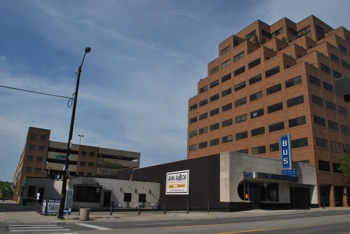
The current site at 116-120 W. Huron, looking north. One North Main is the building on the right. The city’s Ann Ashley parking structure is visible in the background.
Streetscape changes will include curb bump-outs on North Ashley, on the north and south ends of the site for passenger drop-off.
Nine bicycle parking spaces are required for the project, and would include two bike hoops in the North Ashley right-of-way and two in the West Huron right-of-way, for a total of eight bike spaces. Three more hoops are proposed for the Ann Ashley parking structure, with First Martin paying for labor and materials. The city of Ann Arbor and Downtown Development Authority would assume responsibility for maintenance of those hoops.
Construction is estimated to cost $13 million.
In giving the staff report to the planning commission, city planner Alexis DiLeo noted that the Greyhound bus depot has been at that location since 1940, and the site has been a transportation hub since 1898.
Downtown: Bank of Ann Arbor Site Plan
The city council will be asked to approve the site plan for an addition to the Bank of Ann Arbor headquarters at 125 South Fifth Avenue. The planning commission recommended approval of the project at its May 20, 2014 meeting.

Bank of Ann Arbor building at the northeast corner of South Fifth and East Washington. The proposed renovations will create a “tower” entrance into the building at this corner.
The site plan involves reorienting the main entrance – moving it from the center of its South Fifth Avenue side to the southeast corner of South Fifth and East Washington. Existing doors will be replaced with windows. A 9,179-square-foot third-floor addition would be constructed over the rear of the building’s east side. In total, the building would be 32,651 square feet after construction. The project is estimated to cost $4.2 million. [.pdf of staff memo]
According to the staff memo, the design “seeks to transform the current style from contemporary to traditional by replacing the yellow brick façade with brown and red-colored bricks and limestone-colored stone accents and trim and creating a brick and glass tower at the street corner to create a prominent entry.” The original two-story building was constructed in 1965, which included the drive-thru window. An addition was completed in 1999.
The project was evaluated by the city’s design review board on Jan. 14. The board suggested making the entry structure taller and more closely aligning the bank’s design features with those of the adjacent Ameritech building to the east.
The site is zoned D1, which allows for the highest level of density in the downtown area.
D1 zoning requires a special exception use for drive-thrus, which the planning commission considered on May 20 in a separate vote. Because the project is going through a site plan approval process, the requirement for a special exception use was triggered. Special exception uses do not require additional city council approval. The bank has an existing drive-thru teller window on its north side. No changes are planned to that configuration, however.
In giving the staff report to the planning commission, city planner Alexis DiLeo said if the drive-thru were used more frequently, staff might suggest additional design features, like a more clearly marked crossing or differentiated surface materials. But because there are only 20-25 transactions per day at the drive-thru, and given the “successful history” of the existing drive-thru, staff was comfortable with it remaining as is, DiLeo said.
Modifications to drive-thru regulations are in the works, but not yet enacted. The planning commission approved new drive-thru regulations earlier this year. Amendments to Ann Arbor’s zoning ordinance related to drive-thrus received initial approval at the council’s May 5, 2014 meeting, and received final approval at the council’s June 2, 2014 meeting.
Downtown: Liberty Plaza
Mayor John Hieftje and Christopher Taylor (Ward 3) are sponsoring a resolution that would direct the city administrator to “work collaboratively with the property owners adjacent to and near Liberty Plaza, the general public, PAC [park advisory commission], the Ann Arbor District Library, and the DDA to develop a conceptual design for an improved Liberty Plaza…”
Funding for the collaborative work in the amount of $23,577 would come from the parks and recreation budget. In addition to a concept for a “re-imagined Liberty Plaza,” the effort is supposed to result in options for funding construction, to be provided by city staff. A report is to be provided to the park advisory commission by December 2014 and to the city council a month later in January 2015.
This resolution comes in the context of a push by some Ann Arbor residents to establish public park space on top of the underground Library Lane parking garage, which is southwest of Liberty Plaza separated from that park by a surface parking lot owned by First Martin Corp. Related to that, the council voted at its April 7, 2014 meeting – as part of reconsidering a vote it had taken at its previous meeting on March 17 – to designate a 12,000-square-foot portion of the Library Lane surface to be reserved as an urban park.
The result of the reconsidered resolution on April 7 undid the council’s earlier decision to establish a square foot range for the urban plaza – from 6,500-12,000 square feet. That April 7 council decision was made on a 7-4 vote, with dissent from Taylor, Hieftje, Margie Teall (Ward 4) and Chuck Warpehoski (Ward 5).
Courts Human Services
On the council’s June 16 agenda are several items related to the criminal justice system, specifically for some of the specialty courts operated by the 15th District Court.
As part of its consent agenda, the council will be asked to approve an amendment to a $76,242 contract with Washtenaw County Community Support & Treatment Services – for mental health treatment services to people who are participating in the sobriety court and the mental health court. Also on the consent agenda, the council will be asked to approve a $44,200 amendment to a contract with the Washtenaw County sheriff’s office to provide drug abuse screening and monitoring services for the mental health court.
The council will be asked to approve a $108,174 amendment to a contract with the nonprofit Dawn Farm for drug abuse counseling and rehabilitative services. And finally, the consent agenda includes a resolution for a $40,000 amendment to a contract with Reiser and Frushour PLLC to provide legal representation as court-appointed counsel to indigent defendants.
Recycling
The council’s June 16 agenda includes three items related to recycling.
Recycling: RAA Multifamily Pilot
The council will be asked to approve a two-year $95,694 contract with Recycle Ann Arbor for a recycling incentive program for multi-family residential units.
This item is based on the city’s solid waste plan, which the city council adopted at its Oct. 7, 2013 meeting. The plan includes evaluating methods to increase recycling participation through pilot programs. Among those methods is the introduction of a recycling incentive program for multi‐family housing units.
According to the staff memo accompanying this item, a manual sort of waste conducted in the fall of 2012 found that only 12% of the trash that single-family residents threw away was recyclable, compared to 26% of the trash that multi-family residents threw away.
The completion of the pilot program is expected in December 2016.
According to the memo, Recycle Ann Arbor’s proposal includes:
- Gather information on best multi-family recycling practices in North America.
- Survey and/or interview key multi-family constituencies in Ann Arbor to better understand the challenges and opportunities for recycling in this sector. Based on feedback received, develop 3 to 5 methodologies for further testing and analysis.
- Identify pilot parameters and measurement protocols.
- Identify pilot communities to involve in the pilot programs (ultimately targeting approximately 1,000 units) and ramp up pilot start-up.
- Implement pilot programs.
- Analyze results of pilot programs.
- Provide detailed recommendations to the City on best practices and report results to participating multi-family communities.
Methodologies that will be tested as part of the pilot will include the following:
- Recycling rewards program: Evaluate if a recycling rewards program would be effective in improving recycling participation rates in multi-family locations
- Indoor collection bins: Most multi-family locations share outdoor recycling bins. Determine if the provision of indoor recycling bins would help increase recycling rates.
- Multi-family recycling leader program: Determine if the use of recycling leaders at individual locations would help increase recycling rates.
- 300-gallon recycling cart: Determine if the use of 300-gallon carts instead of the standard 96-gallon cart would help increase recycling.
Recycling: Baler Infeed Conveyor Repair
The council will be asked to approve a $39,480 reimbursement to Resource Recovery Systems – the city’s contracted operator of its materials recovery facility (MRF) – for repair of the baler infeed conveyor belt.
According to a staff memo accompanying the item, the belt was last replaced in 2007, and has worn out. Such conveyors are described in the memo as lasting five to seven years.
Recycling: RAA Student Move-out Services
As part of its consent agenda, the council will be asked to approve a $35,000 annual contract with Recycle Ann Arbor for services associated with the move-out of University of Michigan students.
According to the staff memo on the item, RAA’s proposal includes a staffed drop-off location at the corner of Tappan and Oakland streets during student fall and spring move-out periods. The site is also used to collect reusable items (through organizations such as the Salvation Army, Kiwanis, or the Reuse Center), bulky metal items, and recyclable materials.
The Chronicle could not survive without regular voluntary subscriptions to support our coverage of public bodies like the Ann Arbor city council. Click this link for details: Subscribe to The Chronicle. And if you’re already supporting The Chronicle, please encourage your friends, neighbors and colleagues to help support The Chronicle, too!




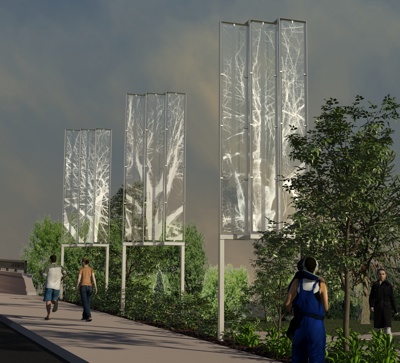

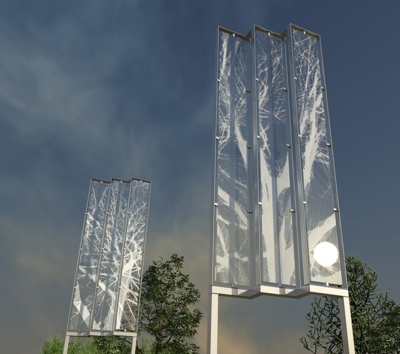

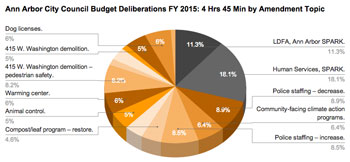
Spend, Spend, Spend. Spend it like it’s somebody else’s money. $400,000 for Stadium Bridges art? Sidewalk construction for $40/square foot? 400 linear feet of city sidewalk is only 25 cubic yards of concrete. A flatwork pour like that is less than $4000 in materials. It just doesn’t add up. Reimbursing the company we hire and pay for the cost of their operations? Madness.